1) In his transformation experiments, what did Griffith observe? 1) _______
A) Infecting mice with nonpathogenic strains of bacteria makes them
resistant to pathogenic strains.
B) Mixing a heat-killed
nonpathogenic strain of bacteria with a living pathogenic strain makes
the pathogenic strain nonpathogenic.
C) Mixing a heat-killed
pathogenic strain of bacteria with a living nonpathogenic strain can
convert some of the living cells into the pathogenic form.
D)
Mice infected with a pathogenic strain of bacteria can spread the
infection to other mice.
C
2) How do we describe transformation in bacteria? 2) _______
A) assimilation of external DNA into a cell
B) the infection
of cells by a phage DNA molecule
C) the creation of a strand of
DNA from an RNA molecule
D) the creation of a strand of RNA from a DNA molecule
A
3) After mixing a heat-killed, phosphorescent (light-emitting) strain of bacteria with a living, nonphosphorescent strain, you discover that some of the living cells are now phosphorescent. Which observation(s) would provide the best evidence that the ability to phosphoresce is a heritable trait? 3) _______
A) especially bright phosphorescence in the living strain
B)
evidence that DNA was passed from the heat-killed strain to the living strain
C) phosphorescence in descendants of the living cells
D)
evidence that protein passed from the heat-killed strain to the living strain
C
4) In trying to determine whether DNA or protein is the genetic material, Hershey and Chase made use of which of the following facts? 4) _______
A) DNA contains phosphorus, whereas protein does not.
B) DNA
contains nitrogen, whereas protein does not.
C) DNA contains
sulfur, whereas protein does not.
D) DNA contains purines,
whereas protein includes pyrimidines.
A
5) Cytosine makes up 42% of the nucleotides in a sample of DNA from an organism. Approximately what percentage of the nucleotides in this sample will be thymine? 5) _______
A)8% B)58% C)42% D)16%
A
6) It became apparent to Watson and Crick after completion of their model that the DNA molecule could carry a vast amount of hereditary information in which of the following? 6) _______
A) phosphate-sugar backbones B) side groups of nitrogenous bases C) sequence of bases D) complementary pairing of bases
C
7) In an analysis of the nucleotide composition of DNA, which of the following will be found?
A) A + C = G + T
B) A = G and C = T
C) G + C = T + A
D) A = C
A
8) For a science fair project, two students decided to repeat the Hershey and Chase experiment, with modifications. They decided to label the nitrogen of the DNA, rather than the phosphate. They reasoned that each nucleotide has only one
phosphate and two to five nitrogens. Thus, labeling the nitrogens would provide a stronger signal than labeling the phosphates. Why won't this experiment work? 8) _______
A) Although there are more nitrogens in a nucleotide, labeled
phosphates actually have sixteen extra neutrons; therefore, they are
more radioactive.
B) Radioactive nitrogen has a half-life of
100,000 years, and the material would be too dangerous for too
long.
C) There is no radioactive isotope of nitrogen.
D) Amino acids (and thus proteins) also have nitrogen atoms; thus, the radioactivity would not distinguish between DNA and proteins.
D
9) Hershey and Chase set out to determine what molecule served as the unit of inheritance. They completed a series of experiments in which E. coli was infected by a T2 virus. Which molecular component of the T2 virus actually ended up insidethecell? 9)_______
A) DNA B) protein C) ribosome D) RNA
A
10) In the polymerization of DNA, a phosphodiester bond is formed between a phosphate group of the nucleotide being added and _____ of the last nucleotide in the polymer. 10) ______
A) the 5' phosphate
B) C6
C) a nitrogen from the
nitrogen-containing base
D) the 3' OH
D
11) Replication in prokaryotes differs from replication in eukaryotes for which of the following reasons?
11) ______
A) The rate of elongation during DNA replication is slower in
prokaryotes than in eukaryotes.
B) Prokaryotic chromosomes have
a single origin of replication, whereas eukaryotic chromosomes have
many. C) Prokaryotes produce Okazaki fragments during DNA replication,
but eukaryotes do not.
D) Prokaryotic chromosomes have histones,
whereas eukaryotic chromosomes do not.
B
12) What is meant by the description "antiparallel" regarding the strands that make up DNA?
A) The 5' to 3' direction of one strand runs counter to the to direction of the other strand.
B) The twisting nature of DNA creates nonparallel strands.
C)
Base pairings create unequal spacing between the two DNA
strands.
D) One strand contains only purines and the other
contains only pyrimidines.
A
13) Suppose you are provided with an actively dividing culture of E. coli bacteria to which radioactive thymine has been added. What would happen if a cell replicates once in the presence of this radioactive base? 13) ______
A) Neither of the two daughter cells would be radioactive.
B)
One of the daughter cells, but not the other, would have radioactive DNA.
C) DNA in both daughter cells would be radioactive.
D) All
four bases of the DNA would be radioactive
C
14) In E. coli, there is a mutation in a gene called dnaB that alters the helicase that normally acts at the origin. Which of the following would you expect as a result of this mutation? 14) ______
A) Replication will require a DNA template from another source.
B) Replication will occur via RNA polymerase alone.
C)
Additional proofreading will occur.
D) No replication fork will
be formed.
D
15) In E. coli, which enzyme catalyzes the elongation of a new DNA strand in the → direction? 15) ______
A)DNAligase B)helicase
C) primase D) DNA polymerase III
D
16) Eukaryotic telomeres replicate differently than the rest of the chromosome. This is a consequence of which of the following? 16) ______
A) the evolution of telomerase enzyme
B) gaps left at the
5" end of the lagging strand
C) DNA polymerase that cannot
replicate the leading strand template to its 5" end
D) gaps left at the 3" end of the lagging strand because of the need for a primer
B
17) How does the enzyme telomerase meet the challenge of replicating the ends of linear chromosomes?
17) ______
A) It adds numerous GC pairs, which resist hydrolysis and maintain
chromosome integrity.
B) It causes specific double-strand DNA
breaks that result in blunt ends on both strands.
C) It adds a
single 5" cap structure that resists degradation by
nucleases.
D) It catalyzes the lengthening of telomeres,
compensating for the shortening that could occur during replication
without telomerase activity.
D
18) The DNA of telomeres has been highly conserved throughout the evolution of eukaryotes. This most likely reflects _____. 18) ______
A) continued evolution of telomeres
B) a critical function of
telomeres
C) that new mutations in telomeres have been advantageous
D) the low frequency of mutations occurring in this DNA
B
19) At a specific area of a chromosome, the sequence of nucleotides below is present where the chain opens to form a replication fork:
3'-CCTAGGCTGCAATCC-5'
An RNA primer is formed starting at the underlined T (T) of the template. Which of the following represents the primer sequence? 19) ______
A) 5"-GCCTAGG-3"
B) 5'-GCCUAGG-3'
C) 5'-ACGUUAGG-3'
D) 5'-ACGTTAGG-3'
C
20) In E. coli, to repair a thymine dimer by nucleotide excision repair, in which order do the necessary enzymes act? 20) ______
A) nuclease, DNA polymerase I, DNA ligase
B) nuclease, DNA
polymerase III, RNA primase
C) helicase, DNA polymerase I, DNA ligase
D) DNA ligase,
nuclease, helicase
A
21) In E. coli, what is the function of DNA polymerase III?
A) to unwind the DNA helix during replication
B) to degrade damaged DNA molecules
C) to seal together the
broken ends of DNA strands
D) to add nucleotides to the 3' end of a growing DNA strand
D
22) The leading and the lagging strands differ in that _____. 22) ______
A) the lagging strand is synthesized continuously, whereas the
leading strand is synthesized in short fragments that are ultimately
stitched together
B) the leading strand is synthesized at twice
the rate of the lagging strand
C) the leading strand is synthesized by adding nucleotides to the 3' end of the growing strand, and the lagging strand is synthesized by adding nucleotides to the 5' end
D) the leading strand is synthesized in the same direction as the movement of the replication fork, and the lagging strand is synthesized in the opposite direction
D
23) A new DNA strand elongates only in the 5' to 3' direction because _____.
A) DNA polymerase can add nucleotides only to the free 3' end
B) DNA polymerase begins adding nucleotides at the 5' end of the template
C) replication must progress toward the replication fork
D) the polarity of the DNA molecule prevents addition of nucleotides at the 3' end
A
24) What is the function of topoisomerase? 24) ______
A)
relieving strain in the DNA ahead of the replication fork
B)
unwinding of the double helix
C) elongating new DNA at a
replication fork by adding nucleotides to the existing chain
D) stabilizing single-stranded DNA at the replication fork
A
25) What is the role of DNA ligase in the elongation of the lagging strand during DNA replication?
A) It joins Okazaki fragments together.
B) It stabilizes the
unwound parental DNA.
C) It unwinds the parental double helix.
D) It synthesizes RNA nucleotides to make a primer.
A
26) Which of the following help(s) to hold the DNA strands apart while they are being replicated?26) ______
A) DNA polymerase B) single-strand DNA binding proteins
C)
primase D) ligase
B
27) Which of the following would you expect of a eukaryote lacking telomerase? 27) ______
A) an inability to produce Okazaki fragments
B) a high
probability of somatic cells becoming cancerous
C) a reduction
in chromosome length in gametes
D) an inability to repair thymine dimers
C
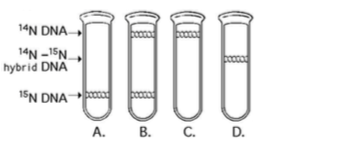
28) In the late 1950s, Meselson and Stahl grew bacteria in a medium containing "heavy" nitrogen (15N) and then transferred them to a medium containing 14N. Which of the results in the figure above would be expected after one round of DNA replication in the presence of 14N?
A) A B) B C) C D) D
D
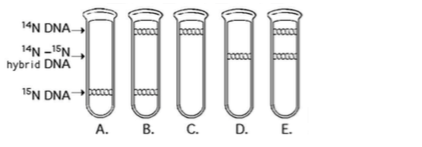
29) After the first replication was observed in their experiments testing the nature of DNA replication, Meselson and Stahl could be confident of which of the following conclusions? 29) ______
A) Replication is not dispersive.
B) Replication is
semi-conservative.
C) Replication is not conservative.
D)
Replication is neither dispersive nor conservative.
C
30) You briefly expose bacteria undergoing DNA replication to radioactively labeled nucleotides. When you centrifuge the DNA isolated from the bacteria, the DNA separates into two classes. One class of labeled DNA includes very large molecules (thousands or even millions of nucleotides long), and the other includes short stretches of DNA (several hundred to a few thousand nucleotides in length). These two classes of DNA probably represent _____. 30) ______
A) leading strands and RNA primers
B) leading strands and Okazaki fragments
C) Okazaki fragments and RNA primers
D) lagging strands and Okazaki fragments
B
31) Within a double-stranded DNA molecule, adenine forms hydrogen bonds with thymine and cytosine forms hydrogen bonds with guanine. This arrangement _____. 31) ______
A) determines the tertiary structure of a DNA molecule
B) permits complementary base pairing
C) determines the type
of protein produced
D) allows variable width of the double helix
B
32) Semiconservative replication involves a template. What is the template?
A) one strand of the DNA molecule B) an RNA molecule
C) DNA
polymerase D) single-stranded binding proteins
A
33) DNA is synthesized through a process known as _____. 33) ______
A) translation B) transcription
C) semiconservative
replication D) conservative replication
C
34) DNA contains the template needed to copy itself, but it has no catalytic activity in cells. What catalyzes the formation of phosphodiester bonds between adjacent nucleotides in the DNA polymer being formed? 34) ______
A) deoxyribonucleotide triphosphates B) ATP C) ribozymes D) DNA polymerase
D
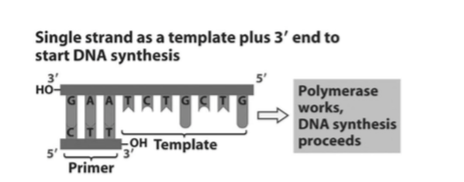
35) Refer to the figure above. What bases will be added to the primer as DNA replication proceeds? The bases should appear in the new strand in the order that they will be added starting at the 3' end of the primer. 35) ______
A)C,A,G,C,A,G,A
B)A,G,A,C,G,A,C
C) T, C, T, G, C, T, G
D) G, T, C, G, T, C, T
B
36) What is a telomere? 36) ______
A) the site of origin of DNA replication
B) the mechanism that
holds two sister chromatids together C) the ends of linear
chromosomes
D) DNA replication during telophase
C
37) Researchers found E. coli that had mutation rates one hundred times higher than normal. Which of the following is the most likely cause of these results? 37) ______
A) There were one or more mismatches in the RNA primer.
B) The DNA polymerase was unable to add bases to the 3' end of the growing nucleic acid chain.
C) The proofreading mechanism of DNA polymerase was not working
properly.
D) The single-stranded binding proteins were malfunctioning.
C
38) In a healthy cell, the rate of DNA repair is equal to the rate of DNA mutation. When the rate of repair lags behind the rate of mutation, what is a possible fate of the cell? 38) ______
A) The cell can be transformed to a cancerous cell.
B) RNA may
be used instead of DNA as inheritance material. C) DNA synthesis will
continue by a new mechanism.
D) The cell will become embryonic.
A
39) If a cell were unable to produce histone proteins, which of the following would be a likely effect?
A) The cell's DNA couldn't be packed into its nucleus.
B)
Amplification of other genes would compensate for the lack of
histones.
C) There would be an increase in the amount of
"satellite" DNA produced during centrifugation.
D) Spindle fibers would not form during prophase.
A
40) Why do histones bind tightly to DNA? 40) ______
A) Histones are positively charged, and DNA is negatively charged.
B) Histones are covalently linked to the DNA.
C) Both histones
and DNA are strongly hydrophobic.
D) Histones are negatively
charged, and DNA is positively charged.
A
41) A particular triplet of bases in the template strand of DNA is 5' AGT 3'. The corresponding codon for the mRNA transcribed is _____.
A) 3-UCA-5
B) 3-ACU-5
C) 5-TCA-3
D) 3-UGA-5
A
42) The genetic code is essentially the same for all organisms. From this, one can logically assume which of the following? 42) ______
A) The same codons in different organisms translate into different
amino acids.
B) A gene from an organism can theoretically be
expressed by any other organism.
C) DNA was the first genetic material.
D) Different organisms
have different types of amino acids.
B

43) The figure above shows a simple metabolic pathway. According to Beadle and Tatum's hypothesis, how many genes are necessary for this pathway? 43) ______
A) 1
B) 2
C) 3
D) It cannot be determined from the pathway.
B
44) Refer to the metabolic pathway illustrated above. If A, B, and C are all required for growth, a strain that is mutant for the gene-encoding enzyme A would be able to grow on medium supplemented with _____. 44) ______
A) nutrient A only B) nutrient B only
C) nutrient C only D)
nutrients A and C
B
45) Refer to the metabolic pathway illustrated above. If A, B, and C are all required for growth, a strain mutant for the gene-encoding enzyme B would be able to grow on medium supplemented with _____. 45) ______
A) nutrient A only B) nutrient B only
C) nutrient C only D)
nutrients A and C
C
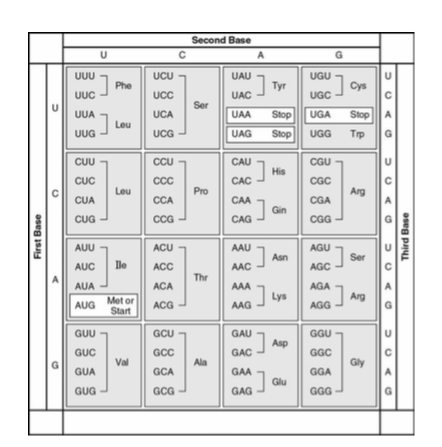
46) A possible sequence of nucleotides in the template strand of DNA that would code for the polypeptide sequence phe-leu-ile-val would be _____.46) ______
A) 5AUG-CTG-CAG-TAT3
B) 5TTG-CTA-CAG-TAG3
C) 3AAA-AAT-ATA-ACA5
D) 3AAA-GAA-TAA-CAA5
D
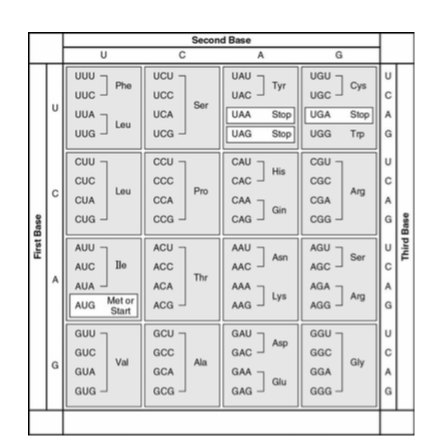
47) What amino acid sequence will be generated, based on the following mRNA codon sequence? 5' AUG-UCU-UCG-UUA-UCC-UUG-3' 47) ______
A) met-ser-leu-ser-leu-ser
B) met-glu-arg-arg-glu-leu
C) met-ser-ser-leu-ser-leu
D) met-arg-glu-arg-glu-arg
C
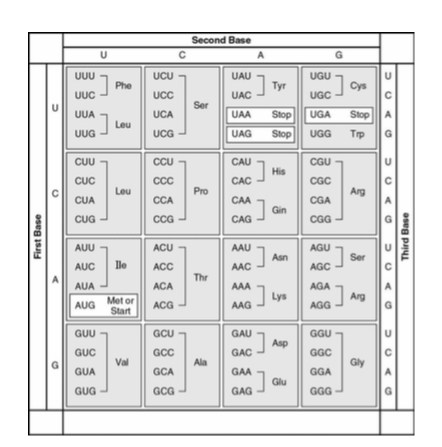
48) Refer to the figure above. What would the anticodon be for a tRNA that transports phenylalanine to a ribosome? 48) ______
A) TTT
B) AAA
C) UUU
D) CCC
B
49) Which of the following is directly related to a single amino acid? 49) ______
A) the three-base sequence of mRNA
B) the amino acetyl tRNA synthase
C) the complementarity of DNA and RNA
D) the base sequence of the tRNA
A
50) In the process of transcription, _____. 50) ______
A) proteins are synthesized B) DNA is replicated
C) RNA is
synthesized D) mRNA attaches to ribosomes
C
51) Codons are part of the molecular structure of _____. 51) ______
A) rRNA B) mRNA C) tRNA D) a protein
B
52) What does it mean when we say the genetic code is
redundant?
A) A single codon can specify the addition of more
than one amino acid.
B) More than one codon can specify the addition of the same amino acid.
C) The genetic code is universal (the same for all organisms).
D) The genetic code is different for different domains of organisms
B
53) According to the central dogma, what molecule should go in the blank? DNA → _____ → Proteins 53) ______
A) tRNA B) mRNA C) rRNA D) mtDNA
B
54) Codons are three-base sequences that specify the addition of a single amino acid. How do eukaryotic codons and prokaryotic codons compare? 54) ______
A) Codons are a nearly universal language among all organisms.
B) Prokaryotic codons usually contain different bases than those of
eukaryotes.
C) The translation of codons is mediated by tRNAs in
eukaryotes, but translation requires no intermediate molecules such as
tRNAs in prokaryotes.
D) Prokaryotic codons usually specify
different amino acids than those of eukaryotes.
A
55) In eukaryotes there are several different types of RNA polymerase. Which type is involved in transcription of mRNA for a globin protein? 55) ______
A) RNA polymerase III B) RNA polymerase I C) RNA polymerase II D) primase
C
56) Transcription in eukaryotes requires which of the following in addition to RNA polymerase?
A) several transcription factors
B) aminoacyl-tRNA synthetase
C) start and stop codons
D) ribosomes and tRNA
A
57) Which of the following best describes the significance of the TATA box in eukaryotic promoters?
A) It is the recognition site for a specific transcription
factor.
B) It is the recognition site for ribosomal
binding.
C) Its significance has not yet been determined.
D) It sets the reading frame of the mRNA.
A
58) Which of the following does not occur in prokaryotic gene expression, but does occur in eukaryotic gene expression? 58) ______
A) RNA polymerase requires a primer to elongate the molecule.
B) A cap is added to the 5' end of the mRNA.
C) RNA polymerase binds to the promoter.
D) mRNA, tRNA, and rRNA are transcribed.
B
59) A ribozyme is _____.59) ______
A) an RNA with catalytic activity
B) an enzyme that catalyzes
the association between the large and small ribosomal subunits C) a
catalyst that uses RNA as a substrate
D) an enzyme that
synthesizes RNA as part of the transcription process
A
60) Alternative RNA splicing _____. 60) ______
A) can allow the production of proteins of different sizes and functions from a single mRNA
B) increases the rate of transcription
C) can allow the
production of similar proteins from different RNAs
D) is a
mechanism for increasing the rate of translation
A
61) In the structural organization of many eukaryotic genes, individual exons may be related to which of the following? 61) ______
A) the various domains of the polypeptide product
B) the
sequence of the intron that immediately precedes each exon
C) the number of start sites for transcription
D) the number
of polypeptides making up the functional protein
A
62) In an experimental situation, a student researcher inserts an mRNA molecule into a eukaryotic cell after she has removed its 5' cap and poly-A tail. Which of the following would you expect her to find? 62) ______
A) The mRNA is quickly converted into a ribosomal subunit.
B) The molecule is digested by enzymes because it is not protected at the 5' end.
C) The mRNA attaches to a ribosome and is translated, but more
slowly.
D) The cell adds a new poly-A tail to the mRNA.
B
63) A primary transcript in the nucleus of a eukaryotic cell is _____ the functional mRNA, while a primary transcript in a prokaryotic cell is _____ the functional mRNA. 63) ______
A) larger than; smaller than
B) larger than; the same size as
C) the same size as; larger than
D) the same size as; smaller than
B
64) A particular triplet of bases in the coding sequence of DNA is AAA. The anticodon on the tRNA that binds the mRNA codon is _____. 64) ______
A) AAA
B) UUA
C) TTT
D) UUU
A
65) Which of the following is the first event to take place in translation in eukaryotes?
A) covalent bonding between the first two amino acids
B)
binding of the larger ribosomal subunit to smaller ribosomal
subunits
C) base pairing of activated methionine-tRNA to AUG of
the messenger RNA
D) the small subunit of the ribosome recognizes and attaches to the 5' cap of mRNA
D
66) A signal peptide _____. 66) ______
A) directs an mRNA
molecule into the cisternal space of the ER
B) terminates translation of messenger RNA
C) signals the
initiation of transcription
D) helps target a protein to the ER
D
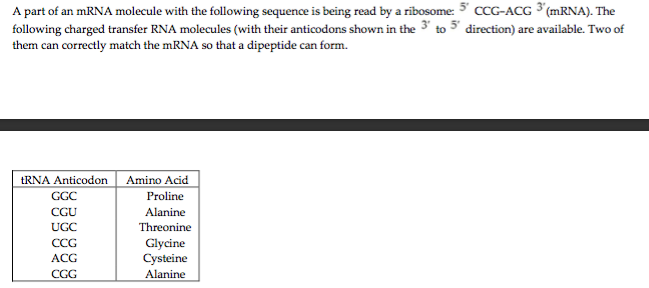
67) The dipeptide that will form will be _____. 67) ______
A) glycine-cysteine B) proline-threonine
C) cysteine-alanine
D) alanine-alanine
B
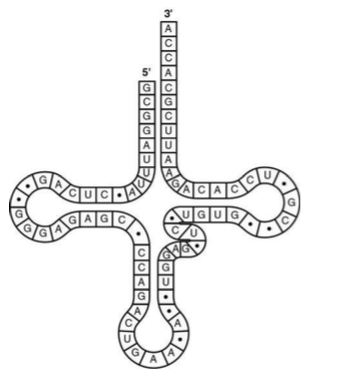
68) What type of bonding is responsible for maintaining the shape of the tRNA molecule shown in the figure above? 68) ______
A) peptide bonding between amino acids
B) van der Waals
interactions between hydrogen atoms
C) ionic bonding between phosphates
D) hydrogen bonding
between base pairs
D
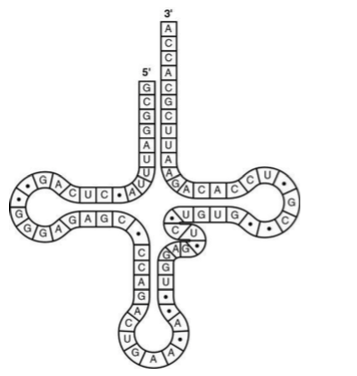
69) The figure above represents tRNA that recognizes and binds a particular amino acid (in this instance, phenylalanine). Which codon on the mRNA strand codes for this amino acid? 69) ______
A) GUA
B) UUC
C) GUG
D) UGG
B
70) The tRNA shown in the figure above has its 3' end projecting beyond its 5' end. What will occur at this end? 70) ______
A) The amino acid binds covalently.
B) The 5' cap of the mRNA
will become covalently bound.
C) The small and large subunits of the ribosome will attach to
it.
D) The excess nucleotides (ACCA) will be cleaved off at the ribosome.
A
71) Translation requires _____.
A) mRNA, DNA, and rRNA
B) mRNA, tRNA, DNA, and rRNA
C) mRNA, tRNA, and rRNA
D) mRNA, tRNA, and DNA
C
72) During elongation, which site in the ribosome represents the location where a codon is being read?
A) A site B) P site
C) E site D) the small ribosomal subunit
A
73) Once a peptide has been formed between the amino acid attached to the tRNA in the P site and the amino acid associated with the tRNA in the A site, what occurs next? 73) ______
A) reading of the next codon of mRNA
B) translocation
C)
initiation
D) The codon-anticodon hydrogen bonds holding the
tRNA in the A site are broken.
B
74) Which one of the following, if missing, would usually prevent translation from starting?
A) poly-A tail B) 5' cap C) exon D) AUG codon
D
75) How does termination of translation take place?
A) The 5' cap is reached.
B) A stop codon is reached.
C)
The poly-A tail is reached.
D) The end of the mRNA molecule is reached.
B
76) Which of the following types of mutation, resulting in an error in the mRNA just after the AUG start of translation, is
likely to have the most serious effect on the polypeptide product?
A) a deletion of a codon
B) a substitution of the first
nucleotide of a GGG codon
C) a substitution of the third nucleotide in an ACC codon
D) a deletion of two nucleotides
D
77) A nonsense mutation in a gene _____. 77) ______
A) changes an amino acid in the encoded protein
B) has no
effect on the amino acid sequence of the encoded protein
C) alters the reading frame of the mRNA
D) introduces a
premature stop codon into the mRNA
D
78) Which of the following DNA mutations is most likely to damage the protein it specifies?
A) a codon deletion B) a base-pair deletion
C) a substitution
in the last base of a codon D) an addition of three nucleotides
B
79) An original section of DNA has the base sequence AGCGTTACCGT. A mutation in this DNA strand results in the base sequence AGGCGTTACCGT. This change represents _____.79) ______
A) a missense mutation B) a point mutation
C) frameshift mutation D) a silent mutation
C
80) A single base substitution mutation is least likely to be deleterious when the base change results in _____. 80) ______
A) an amino acid substitution that alters the tertiary structure of
the protein B) a stop codon
C) a codon that specifies the same
amino acid as the original codon
D) an amino acid substitution
at the active site of an enzyme
C